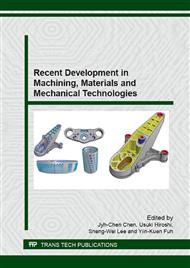[1]
W.C. Dash, Growth of Silicon Crystals Free from Dislocations, Journal of Applied Physics. 30 (1959) 459-474.
DOI: 10.1063/1.1702390
Google Scholar
[2]
M.L. Polignano, G.F. Cerofolini, H. Bender, C. Claeys, J. Reffle, Lifetime Engineering by Oxygen Precipitation in Silicon, 17th European Solid State Device Research Conference. (1987) 335-338.
Google Scholar
[3]
S.M. Hu, Effects of ambients on oxygen precipitation in silicon, Applied Physics Letters. 36 (1980) 561-564.
DOI: 10.1063/1.91546
Google Scholar
[4]
R.A. Craven, Oxygen Precipitation in Silicon, IEEE International Electron Devices Meeting. (1981) 228-231.
Google Scholar
[5]
S. Isomae, Computer‐aided simulation for oxygen precipitationin silicon, Journal of Applied Physics. 70 (1991) 4217-4223.
DOI: 10.1063/1.349147
Google Scholar
[6]
A. Borghesi, B. Pivac, A. Sassella, A. Stella, Oxygen precipitation in silicon, Journal of Applied Physics. 77 (1995) 4169-4244.
DOI: 10.1063/1.359479
Google Scholar
[7]
s. Senkader, J. Esfandyari, G. Hobler, A model for oxygen precipitation in silicon including bulk stacking fault growth, Journal of Applied Physics. 78 (1995) 6469-6476.
DOI: 10.1063/1.360532
Google Scholar
[8]
H. -D. Chion and J. Schumate, Effect of Oxygen Content, Backside Damage and Polyslilcon Backsealed Substrate on Switching Transistors and Diodes, IEEE International Conference on Semiconductor Electronics. (1996) 105-108.
DOI: 10.1109/smelec.1996.616463
Google Scholar
[9]
Q. Wang, M. Daggubati, R. Yu, X.F. Zhang, High temperature nitrogen annealing induced interstitial oxygen precipitation in silicon epitaxial layer on heavily arsenic-doped silicon wafer, Applied Physics Letters, 88 (2006) 242112 - 242112-3.
DOI: 10.1063/1.2213516
Google Scholar
[10]
C. Gao, X. Ma, J. Zhao, D. Yang, Effect of tin on point defects and oxygen precipitation in Czochralski silicon: Experimental and theoretical studies, Journal of Applied Physics, 113 (2013), 093511 - 093511-8.
DOI: 10.1063/1.4794531
Google Scholar
[11]
X. Zhang, C. Ghao, M. Fu, X. Ma, J. Vanhellemont, D. Yang, Impact of rapid thermal processing on oxygenprecipitation in heavily arsenic and antimony doped Czochralski silicon, Journal of Applied Physics, 113 (2013), 163510 - 163510-7.
DOI: 10.1063/1.4803061
Google Scholar
[12]
B. Birouk, M. Bouzerdoum, D. Madi, MOS structures quality under annealing influence, International Conference on Applied Electronics. (2013) 1-4.
Google Scholar
[13]
E. Rosencher, D. Bois, Comparison of interface state density in MIS structure deduced from DLTS and Terman measurements, Electronics Letters. 18 (1982) 545 - 546.
DOI: 10.1049/el:19820369
Google Scholar


